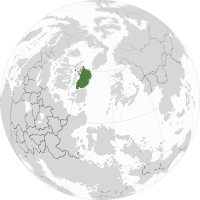Laifelais: Difference between revisions
Dantedante (talk | contribs) No edit summary |
Dantedante (talk | contribs) No edit summary |
||
| Line 103: | Line 103: | ||
|} | |} | ||
'''Laifelais''', officially the '''Concordant Consortiums of Laifelais''', is a country located in [[X region]], eastern [[Legexet]]. Though it shares no land borders with any nation, its [[Greater Laifelais|mainland]] shares a [[wikipedia:Maritime boundary|maritime border]] with [[Sow]] to the west and south, [[Yigó]] to the northwest, [[Lyrameian Republic of Xet|Xet]] to the north, and [[Krukyr]] to the east. Its [[Overseas territories of Laifelais|overseas territories]] consist of [[X]], [[Y]], [[Z]], and [[A]]. It has a total land area of X square kilometers and is the Xth largest country in [[Legexet]]. Laifelais is a [[Eruism|Eruist]] [[wikipedia:Theocracy|theocratic]] [[wikipedia:Republic|republic]], and is divided into 7 regional [[Domains of Laifelais|Domains]] that act as administrative regions with 71 [[Consortiums (Eruism)|Consortiums]] as the nation's second-level subdivisions. Its capital of [[Aistana]] is the national administrative center and the religious center of [[Eruism]]. The largest city, [[Ancalë]], is the economic and cultural center | '''Laifelais''', officially the '''Concordant Consortiums of Laifelais''', is a country located in [[X region]], eastern [[Legexet]]. Though it shares no land borders with any nation, its [[Greater Laifelais|mainland]] shares a [[wikipedia:Maritime boundary|maritime border]] with [[Sow]] to the west and south, [[Yigó]] to the northwest, [[Lyrameian Republic of Xet|Xet]] to the north, and [[Krukyr]] to the east. Its [[Overseas territories of Laifelais|overseas territories]] consist of [[X]], [[Y]], [[Z]], and [[A]]. It has a total land area of X square kilometers and is the Xth largest country in [[Legexet]]. Laifelais is a [[Eruism|Eruist]] [[wikipedia:Theocracy|theocratic]] [[wikipedia:Republic|republic]], and is divided into 7 regional [[Domains of Laifelais|Domains]] that act as administrative regions with 71 [[Consortiums (Eruism)|Consortiums]] as the nation's second-level subdivisions. Its capital of [[Aistana]] is the national administrative center and the religious center of [[Eruism]]. The largest city, [[Ancalë]], is the economic and cultural center and is the former capital city before it was moved to Aistana in 1060. | ||
The first known settlements on the island of Laifelais were found in the southern coastal regions on what is now the Domain of [[Airon]], dating back to the [[Palaeolithic Era]]. The inhabitants of the island would first [[wikipedia:Neolithic revolution|introduce agriculture]] to the southern river valleys. The early inhabitants of the island would also be one of the first centers of the global chalcolithic period as copper production was found earlier compared to its region. By the time of the [[First Wave]] of [[wikipedia:Human|human inhabitants]] arrived to the world, the Nórë would quickly elevate to the Bronze Age as they adopted the bronzemaking knowledge of humanity, thus forming the first of the Laifelish bronze age societies on the island. The later collapse of the bronze age and the transition to the Iron Age would see the rise of the ancient cities of [[Arnen]] and [[Ancalë]]. The Age of Antiquity would see the rise of Arnen as a highly influential city-state in the region, becoming the [[Arnen Dominion]] and dominating the island and its surrounding regions for years to come. The medieval era would see the rise of [[wikipedia:Petty kingdom|petty kingdoms]] at the wake of the [[Era of Asundering|Dominion's collapse]], giving rise to early feudal polities on the island. The petty kingdoms would soon be conquered and the entirety of the island united under the era of the [[High Kingdom of Laifelais|High Kingdom]] that would span for much of the medieval age. The [[Eruism|Temple of Eru]] would also gain considerable influence and power in this time. With the coming of the [[Second Wave]] of humans to the world, the disproportionate technological difference between the medieval Laifelais caused the downfall of the High Kingdom as the [[Laifelish-Second Waver Conflicts|several wars]] incurred upon them pushed the kingdom to a breaking point. A rising societal group known as the [[Enlightened]] would quickly gain influence and, alongside the Eruist Temple, would launch a [[1054 Eruite Revolution|revolution in 1054]] to topple the monarchy and install a new [[wikipedia:Technocracy|technologically reformist]] theocratic republic under the [[wikipedia:Authoritarianism|authoritarian]] rulership of the Temple. | The first known settlements on the island of Laifelais were found in the southern coastal regions on what is now the Domain of [[Airon]], dating back to the [[Palaeolithic Era]]. The inhabitants of the island would first [[wikipedia:Neolithic revolution|introduce agriculture]] to the southern river valleys. The early inhabitants of the island would also be one of the first centers of the global chalcolithic period as copper production was found earlier compared to its region. By the time of the [[First Wave]] of [[wikipedia:Human|human inhabitants]] arrived to the world, the Nórë would quickly elevate to the Bronze Age as they adopted the bronzemaking knowledge of humanity, thus forming the first of the Laifelish bronze age societies on the island. The later collapse of the bronze age and the transition to the Iron Age would see the rise of the ancient cities of [[Arnen]] and [[Ancalë]]. The Age of Antiquity would see the rise of Arnen as a highly influential city-state in the region, becoming the [[Arnen Dominion]] and dominating the island and its surrounding regions for years to come. The medieval era would see the rise of [[wikipedia:Petty kingdom|petty kingdoms]] at the wake of the [[Era of Asundering|Dominion's collapse]], giving rise to early feudal polities on the island. The petty kingdoms would soon be conquered and the entirety of the island united under the era of the [[High Kingdom of Laifelais|High Kingdom]] that would span for much of the medieval age. The [[Eruism|Temple of Eru]] would also gain considerable influence and power in this time. With the coming of the [[Second Wave]] of humans to the world, the disproportionate technological difference between the medieval Laifelais caused the downfall of the High Kingdom as the [[Laifelish-Second Waver Conflicts|several wars]] incurred upon them pushed the kingdom to a breaking point. A rising societal group known as the [[Enlightened]] would quickly gain influence and, alongside the Eruist Temple, would launch a [[1054 Eruite Revolution|revolution in 1054]] to topple the monarchy and install a new [[wikipedia:Technocracy|technologically reformist]] theocratic republic under the [[wikipedia:Authoritarianism|authoritarian]] rulership of the Temple. | ||
Revision as of 07:49, 7 July 2025

| |||||||

| |||||||

Location of Laifelais (green) | |||||||
| General Information | |||||||
|---|---|---|---|---|---|---|---|
| Official Name | Concordant Consortiums of Laifelais | ||||||
| Common Name | Laifelais | ||||||
| Demonym | Laifelish | ||||||
| Capital | Aistana | ||||||
| Largest City | Ancalë | ||||||
| Official Language(s) | Taróma, Laifelish | ||||||
| Species | 92.2% Nórë 5.6% Human 2.2% Others | ||||||
| Ethnic Groups | 93.5% Laifelish 3.2% Sowish 1.4% Xet 1.2% Agimanians 0.7% Others | ||||||
| Religion |
| ||||||
| Government | |||||||
| Government Type | Unitary parliamentary theocratic Eruist republic under an authoritarian government | ||||||
| High Consort | Cala Elara | ||||||
| Grand Custodian | Tuor Aran | ||||||
| Legislature | |||||||
| Legislature | Concordant Council | ||||||
| Formation | |||||||
| Eruite Revolution | 1054 | ||||||
| Geography | |||||||
| Continent | Legexet, Agiman (Overseas Territories) | ||||||
| Region | - | ||||||
| Area (km²) | - | ||||||
| Area (mi²) | - | ||||||
| % Water | - | ||||||
| Borders | N/A | ||||||
| Population | |||||||
| Population | 48,859,865 | ||||||
| Census Year | 1125 | ||||||
| Density (/km²) | - | ||||||
| Economy | |||||||
| Currency | Laifelish Mihta (մ) (LFM) | ||||||
| GDP (PPP) | $2.13 trillion | ||||||
| GDP per capita (PPP) | $43,615 | ||||||
| GDP (Nominal) | $1.54 trillion | ||||||
| GDP per capita (Nominal) | $31,583 | ||||||
| Gini Coefficient | .48 (1125) — medium inequality | ||||||
| HDI | 0.882 (1125) – very high | ||||||
| Other | |||||||
| Date format | YYYY/MM/DD | ||||||
| Internet TLD | .lf | ||||||
| Driving side | right | ||||||
| Calling Code | +043 | ||||||
Laifelais, officially the Concordant Consortiums of Laifelais, is a country located in X region, eastern Legexet. Though it shares no land borders with any nation, its mainland shares a maritime border with Sow to the west and south, Yigó to the northwest, Xet to the north, and Krukyr to the east. Its overseas territories consist of X, Y, Z, and A. It has a total land area of X square kilometers and is the Xth largest country in Legexet. Laifelais is a Eruist theocratic republic, and is divided into 7 regional Domains that act as administrative regions with 71 Consortiums as the nation's second-level subdivisions. Its capital of Aistana is the national administrative center and the religious center of Eruism. The largest city, Ancalë, is the economic and cultural center and is the former capital city before it was moved to Aistana in 1060.
The first known settlements on the island of Laifelais were found in the southern coastal regions on what is now the Domain of Airon, dating back to the Palaeolithic Era. The inhabitants of the island would first introduce agriculture to the southern river valleys. The early inhabitants of the island would also be one of the first centers of the global chalcolithic period as copper production was found earlier compared to its region. By the time of the First Wave of human inhabitants arrived to the world, the Nórë would quickly elevate to the Bronze Age as they adopted the bronzemaking knowledge of humanity, thus forming the first of the Laifelish bronze age societies on the island. The later collapse of the bronze age and the transition to the Iron Age would see the rise of the ancient cities of Arnen and Ancalë. The Age of Antiquity would see the rise of Arnen as a highly influential city-state in the region, becoming the Arnen Dominion and dominating the island and its surrounding regions for years to come. The medieval era would see the rise of petty kingdoms at the wake of the Dominion's collapse, giving rise to early feudal polities on the island. The petty kingdoms would soon be conquered and the entirety of the island united under the era of the High Kingdom that would span for much of the medieval age. The Temple of Eru would also gain considerable influence and power in this time. With the coming of the Second Wave of humans to the world, the disproportionate technological difference between the medieval Laifelais caused the downfall of the High Kingdom as the several wars incurred upon them pushed the kingdom to a breaking point. A rising societal group known as the Enlightened would quickly gain influence and, alongside the Eruist Temple, would launch a revolution in 1054 to topple the monarchy and install a new technologically reformist theocratic republic under the authoritarian rulership of the Temple.